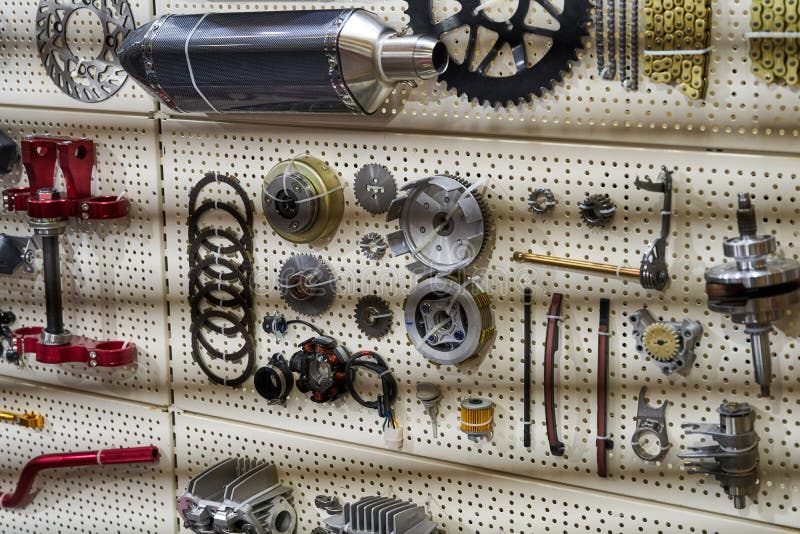Recognizing the Important Parts of a Motorbike: A Comprehensive Overview for Enthusiasts
For motorbike fanatics looking to elevate their riding experience and ensure their bikes run efficiently, comprehending the important elements of a motorcycle is extremely important. Each component, from the engine's elaborate operations to the critical duty of the stopping systems, not only influences performance however likewise security and convenience.
Engine Elements

The camshaft plays a vital duty in controlling the timing of the engine's valves, making sure the exact opening and closing essential for efficient gas and air intake, in addition to exhaust expulsion. This timing is essential to keeping ideal engine efficiency and efficiency. Furthermore, the carburetor or gas shot system, depending upon the bike design, is accountable for mixing air with gas in the proper ratio for burning.
The air conditioning system, either air or liquid-based, works to maintain the engine's temperature within functional restrictions, protecting against getting too hot and making certain longevity - mx gear nz. Each component, carefully made and incorporated, adds to the smooth procedure of the engine, specifying the motorbike's power outcome and overall performance
Transmission System
Indispensable to the bike's performance, the transmission system makes sure reliable power transfer from the engine to the wheels. This system comprises several critical parts, including the clutch, transmission, and last drive, each playing a crucial role in converting the engine's power into activity. The clutch, usually operated by a hand lever, serves to engage and disengage the engine from the transmission, enabling smooth gear modifications and controlled acceleration.
The transmission, often described as the transmission proper, includes a collection of gears that motorcyclists can manually change through to change the bike's rate and torque output. These equipments are arranged in a sequence that allows the bike to increase efficiently and keep ideal engine performance across different rates. The majority of motorcycles make use of a consecutive transmission, calling for the cyclist to change equipments in a predetermined order.
Braking Devices
While comprehending the transmission system is key to utilizing a bike's power, equally important is the capability to regulate and stop that power properly, which is where stopping systems enter into play. Brakes are vital for security and efficiency, providing the biker with the required control to browse various surfaces and conditions. Commonly, bikes feature two sorts of stopping systems: disc brakes and drum brakes.
Disc brakes are much more common in modern-day motorbikes due to their superior efficiency. This system uses much better warmth dissipation, regular performance, and boosted stopping power, especially in wet problems.
On the other hand, drum brakes, though less common, are still located in some bikes. They function by pressing brake footwear versus the inner surface area of a drum affixed to the wheel. While usually less efficient in warm dissipation and quiting power, drum brakes are simpler and extra economical.
Understanding these braking systems' subtleties permits bikers to maintain their bikes effectively and value the engineering that makes sure effective and risk-free stopping.
Suspension and Guiding
Suspension and guiding systems are essential parts that dramatically influence a motorbike's handling and ride comfort. The suspension system, containing forks at the front and shock absorbers at the back, soaks up roadway abnormalities, enhancing stability and control. Front forks, usually telescopic or upside down, compress and rebound to mitigate effects, while back shock absorbers keep tire contact with the road, important for traction and safety.
Steering, focused around the handlebars, links the biker to the bike's directional control. The steering head bearings make certain smooth operation, enabling accurate maneuverability. Appropriate positioning and upkeep of these bearings are important for foreseeable guiding feedback article and reducing rider tiredness.
The suspension's adjustability is another crucial aspect; preload, damping, and rebound settings allow customization to match numerous riding designs and problems. This flexibility is crucial for optimizing efficiency, whether navigating urban streets or dealing with tough routes. Advancements like digital shock absorber supply real-time adjustments, boosting experience quality throughout varied surfaces.

Electric Systems
After making sure a smooth and regulated ride via news efficient suspension and guiding systems, attention turns to the electrical systems, a critical facet of contemporary motorcycles. These systems play an essential role not just in beginning the engine but additionally in powering various elements that improve the performance and safety of the motorbike.
At the heart of a bike's electrical system is the battery, which stores electric power essential for starting the engine and powering complementary systems - motox parts nz. The generator or generator, paired with the rectifier-regulator, guarantees the battery continues to be billed while the motorbike is in procedure, transforming power right into electric power and keeping voltage levels
The ignition system, an additional vital element, is in charge of igniting the air-fuel mixture in the engine's cyndrical tubes. Modern bikes usually use an electronic ignition system, offering greater performance and reliability contrasted to standard systems.
Lights systems, including headlights, tail lights, and signs, are likewise vital, guaranteeing exposure and safety and security for the motorcyclist. Additional look at this web-site electronic parts such as sensing units, control devices, and presents add to innovative functions like fuel injection management, anti-lock braking systems (ABDOMINAL MUSCLE), and electronic dashboards, additionally enhancing the riding experience.
Conclusion
An extensive understanding of a motorbike's crucial parts, including the engine, transmission system, braking systems, suspension, steering, and electrical systems, is vital for fanatics intending to maximize safety and security, performance, and convenience. Proficiency of these components enables for educated choices concerning maintenance and upgrades, inevitably improving the riding experience. By incorporating this understanding, cyclists can ensure their bikes operate at peak performance and integrity, thus maximizing both pleasure and long life of their automobiles.
For bike fanatics looking to raise their riding experience and ensure their bikes run efficiently, comprehending the necessary components of a motorbike is extremely important.Indispensable to the motorbike's capability, the transmission system makes certain efficient power transfer from the engine to the wheels.While comprehending the transmission system is vital to utilizing a motorcycle's power, similarly vital is the ability to regulate and quit that power effectively, which is where stopping devices come into play. Usually, motorcycles feature 2 types of stopping systems: disc brakes and drum brakes.
A detailed understanding of a bike's essential components, consisting of the engine, transmission system, stopping devices, suspension, guiding, and electrical systems, is vital for fanatics intending to maximize comfort, performance, and safety and security.